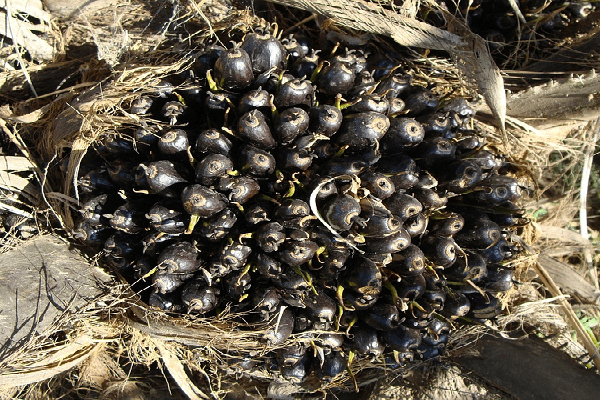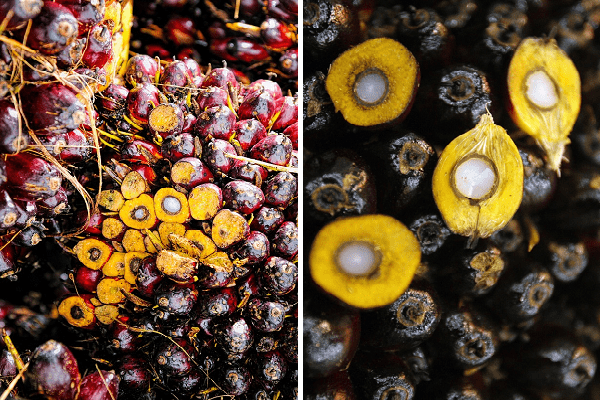Healthy food >>>> Palm oil - food and technical properties
Palm oil - food and technical properties.


There are many prejudices stuck behind palm oil, which is not at all related to the harmful effects of this food product, but to a misunderstanding of where the border lies between the nutritional value and technical characteristics of palm oil?
The tropical plant Elaeis guineensis (Eleis of Guinea) is known since BC as a source of natural fats, which gave it the name "oil palm". This is not to say that the fats extracted from this plant are a modern trend in the production of vegetable oils. The fruits of the plant are so "fat" that oil can be obtained by simply squeezing the pulp under pressure (by hand or under pressure).


Since the oil palm requires special growth conditions (the plant is quite whimsical), the plantations are bred in an area with a climate similar to its homeland - equatorial Africa. African oil palm plantations are located in Malaysia and Indonesia, where the plant is artificially created conditions for accelerated growth and fruiting. The plant is so sensitive to light and temperature conditions that even slight shading, such as during the tropical rainstorm season, can ruin the crop. If the temperature, humidity and light are not high enough, the plant produces male inflorescences in larger quantities than female inflorescences, but the fruits appear only when female inflorescences are pollinated.


Palm oil and palm kernel oil.
What is commonly called palm oil actually has two separate names, which determine the difference in the use of the product obtained from the fruit of the oil palm. Palm oil is a product of the extraction of the fatty component of the flesh of the Elaeis guineensis palm fruit (the amniotic layer of the pulp). But the plant seeds are also rich in oily fractions, from which palm kernel oil with a higher melting point is obtained - the same refractory fats, the presence of which in oil palm products is of concern.
Both types of palm oil differ in color and melting point. So the vegetable oil from the pulp of the fruit of the oil palm has a pronounced orange (or red-orange, orange-brown) color, it is more fusible (at 13-16 degrees it begins to turn into solid fractions (stearin) - thicken) in comparison with palm kernel oil, the melting point of which reaches 45-55 degrees. The larger the fractional component of stearins, the higher the refractoriness of palm oil, the larger the fractional component of oleins, the lower the melting point. So on average, the melting point of palm oil reaches forty degrees. It all depends on how enriched the palm oil is. For example, in oil from the pulp of oil palm, the ratio of stearin to olein is 25:75.


Vegetable fats extracted from the pulp of fruits - palm oil itself - are used in the food, pharmaceutical and cosmetic industries. Solid fats, isolated by a more complex technological method from plant seeds, are classified as oleochemicals. They are used in medicine to obtain suppositories, bases for ointments and creams, glycerin; used in cosmetology as components of masks with a softening effect on the skin, as a basis for creams, lipsticks, oily shadows and tonal creams, for decorative and camouflage cosmetics; in the household industry as excellent detergents with low foaming (as an ingredient in toothpastes, body gels, hair shampoos; as an independent component in soap, as an ingredient in dish detergents).
Harmful sodium salts (sodium lauryl sulfate) - surfactants that are part of most detergents have found a competitor - dietonolamides (fatty alcohols), which are part of the fatty acids of palm kernel oil. These harmless substances are included in detergents for washing machines as substances with a low degree of foaming.
The domestic use of palm and palm kernel oil solids extends far beyond the soap industry (it is a favorite ingredient in high quality soap). A very rare natural property of vegetable fats - refractoriness, became the reason for replacing animal fats with artificially created refractory properties (transgenic fats) with vegetable palm and palm kernel oil. So the modern production of candles, technical creams for shoes and leather goods, technical machine lubricants can no longer do without the participation of palm oil.
Palm and palm kernel oils have created serious competition for fat-containing petroleum products.
Palm oil in medicine and cosmetology.
Pharmacological and cosmetic production of products with the whole complex of palm oil fats relies on the advantage of palm oil and its constituent fatty acids, as a component that does not have sensitizing properties (absolutely non-allergenic product). In addition, the high content of carotenoids in palm oil obtained by pressing the fruit pulp increases the regenerative capabilities of ointments and creams when applied to the skin or mucous membranes.
Ointments and creams based on palm oil have high keratoplastic properties that exceed the reparative capabilities of carotene-containing oils (Sea buckthorn oil, Rosehip oil, Shea butter, St. John's wort oil). Palm oil is a perfect skin softener and protective material when it is necessary to close damage on the skin, for example, in case of skin diseases, dermatitis.
What kind of palm oil is used for food?
Despite the fact that palm oil is a highly valuable product in various areas of technical industrial use, it is used in the culinary and food industry for the preparation of food. But not all types of palm oil are used as food. For oral consumption, palm oil is used with a low content of stearins (stearic fatty acid) and a high content of palmitic and oleic fatty acids. Palm oil of this quality is obtained only by pressing the pulp of the fruit of the oil palm, and it is called Red Palm Oil.
The solid (stearins) and liquid (oleins) fractions are separated by heating to make the oil edible. However, in the food industry and home cooking, palm oil varieties with a higher melting point can also be used. Such palm oil is needed where crunchy dough is being prepared (instead of margarine and lard) or products with thickeners, where palm oil plays the role of a thickener and fat at the same time, for example, in the production of ice cream, cakes with thick creams, sweets, pastries, cheeses, cottage cheese, etc.
High-melting palm oil is not very good for the body, as are margarine and lard (rendered animal fat). But in order to understand in favor of which product to make a choice, you need to know that margarines are obtained by hydrolysis of animal fats or by hydrogenation of inexpensive liquid vegetable oils. In addition, in terms of the content of polyunsaturated fatty acids, palm oil is much healthier than butter or butter from cocoa beans (what chocolate is made of), not to mention margarine as a 100% source of trans fats.
There is a misconception that the harm of palm oil lies in its refractoriness, which does not coincide with body temperature, which presumably creates conditions for the difficulty of digestion of palm oil and its settling on the walls of blood vessels. But the digestion process, although it takes place under the conditions of the temperature regime of our body, is not associated with the melting of fats so that they can be absorbed - this is done by gastric and intestinal enzymes that break down fats long before they enter the vascular system. Concern about the absorption of fats, including refractory fats, can arise only in people suffering from enzymatic insufficiency, for example, low acidity of gastric juice, which is directly involved in the breakdown of fats.
Red Palm Oil - this type of palm oil is very useful for the body in terms of the content of vitamin A and vitamin E. In terms of its quantitative indicators, palm oil of this type is several orders of magnitude ahead of the recognized leaders of the plant world - sweet potatoes and carrots, as well as representatives of products in terms of retinol content food of animal origin with a high content of retinol (vitamin A) and tocopherol (vitamin E) - liver and fish oil. It must be said that in terms of retinol content among food products, Red Palm Oil (30,000 mcg per 100 g of product) has no competitors except fish oil (25,000 mcg per 100 g of product).
Red Palm Oil differs from other types of vegetable oil in its bright reddish-orange color and a specific smell of violets. Palm kernel oil has a nutty smell and a palette of colors ranging from colorless to various shades of yellow. Red Palm Oil (also known as "palm olein") is sold in hermetically sealed containers like olive oil, while palm kernel oil is sold in briquettes in plastic or paper packaging or in cans.

Read

Read



























